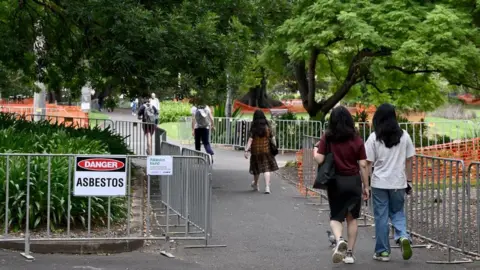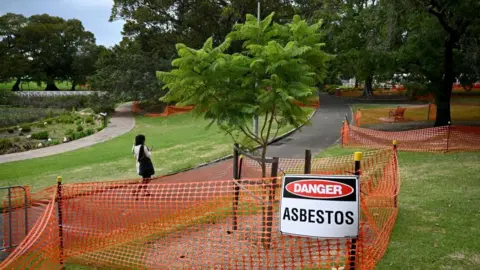Sydney asbestos scare: How a mulch discovery has sent a city scrambling
 EPA
EPAIn January, an Australian child innocently brought home a couple of handfuls of garden mulch from near a playground in Sydney's inner west.
Looking at the mulch, the child's parent was horrified to spot what looked like chunks of bonded asbestos.
Their call to authorities has since revealed a contamination crisis which has now spread across the city, forcing the closure of many public parks, playgrounds and several schools.
As of Monday, 33 sites in Sydney and another in the town of Nowra had tested positive for the cancer-causing substance.
In addition to parks and schools, they include supermarkets, hospitals, housing estates and train stations.
New South Wales (NSW) officials now say there could be tainted woodchips at hundreds of locations.
The state's government and environmental watchdog have set up a taskforce to investigate.
The mayor of the Inner West Council - which takes in the original exposure site at Rozelle Parklands - said the situation was "beyond belief".
"As a parent whose children have been playing there myself, I understand how concerning this will be for many thousands of local people," Darcy Byrne said.
The scare has kept thousands of school students at home and forced the cancellation of a major Mardi Gras party. There was also panic after potential exposure sites were identified - but quickly cleared - at the Sydney venue for Taylor Swift's Eras Tour concert.
State officials say they are working as quickly as possible to identify and test locations of concern.
"We do understand that it is a big problem... There is no doubt that there is a failure here," NSW Environment Minister Penny Sharpe said.
Assessing the danger
Health authorities have warned the public to steer clear of the contaminated areas, which have been cordoned off.
But they have also sought to downplay the potential risk they pose.
Extended exposure to asbestos - which was once widely used in construction materials - can lead to a form of cancer called mesothelioma or the chronic lung disease asbestosis.
Most of the asbestos found so far is "bonded", often with cement, which means it is less likely to break down and be inhaled. But one piece of the more concerning friable asbestos - which can be easily crushed into a powder - was found at a public park in suburb Surry Hills.
 Getty Images
Getty Images"It's really a material that primarily needs to be breathed in to be a risk," said NSW Health's Dr Jeremy McAnulty.
"Touching it, or just being in the environment, is typically not a risk for asbestos-related disease."
Generally people need to breathe in a lot of the substance, and over a long period of time, to fall sick, he added.
The related illnesses take years - sometimes decades - to develop, and there is generally no testing for people who might have been exposed in the short term.
Australia began phasing out asbestos in the 1980s and banned it in 2003.
Where is it coming from?
All of the tainted mulch found so far has been supplied by landscaping products manufacturer Greenlife Resource Recovery, local media have reported.
The Environment Protection Authority (EPA) earlier this month banned the company from moving - or selling - the mulch from its facility in Bringelly, in south-western Sydney, while the watchdog investigates.
But the firm has repeatedly denied it is the source of the contamination, and it has launched a legal challenge over the ban.
They say their mulch has been tested repeatedly since the scare began - even by the EPA - and all results have been negative.
"There are media reports suggesting because [our facility] is the common source, then it must be responsible for the asbestos contamination. This is incorrect," it said in a statement, arguing that contamination could have occurred at any point along the supply chain.
 EPA
EPAThe EPA is now undertaking a criminal investigation - believed to be the largest in state history - to find out "who has done the wrong thing", the environment minister said.
Premier Chris Minns has added: "If there's been a breach of the law then, of course, we'll throw the book at them."
But the saga has also put a spotlight on regulatory checks in NSW.
By law, suppliers must ensure mulch does not contain a range of contaminants like asbestos, engineered wood products, glass, metal or plastics - but it does not impose any specific testing requirements.
Some members of state parliament are calling for reform, which the government has said it will consider if recommended by the EPA.
